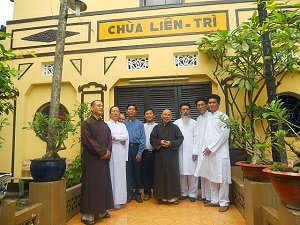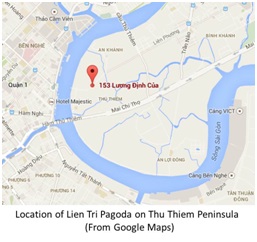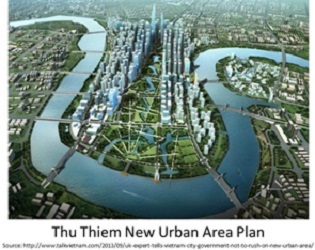Chùa Liên Trì Trong Chính Sách Đàn Áp Tôn Giáo Của Công Sản Việt Nam
Thời gian gần đây, dư luận trong nước, hải ngoại và quốc tế hết sức phẫn nộ trước các cuộc đàn áp nhân quyền được thực thi bởi Hà Nội, đặc biệt là chiến dịch triệt hạ các cở sở tôn giáo không nằm dưới sự quản lý của Đảng.
Chùa Liên Trì là một trong các trọng tâm của chính sách tiêu diệt tôn giáo được chính quyền nổ lực thực hiện dưới danh nghĩa “ thực thi các biện pháp cưỡng chế hành chính”. Thủ đoạn “quy kết” trách nhiệm cho các đơn vị hành chính nhỏ nhất tại địa phương giúp chính quyền Hà Nội có đầy đủ các bằng chứng ngoại phạm trước sự quan sát của quốc tế, giảm thiểu mọi nguy cơ dẫn đến bất lợi trong các cuộc đàm phán với chính giới phương Tây.
Chúng tôi cung cấp chi tiết thông tin về chùa Liên Trì như bằng chứng vi phạm nhân quyền trắng trợn của chính phủ Việt Nam cho công luận am tường.
Chùa Liên Trì tọa lạc trên bán đảo Thủ Thiêm đối diện khu Trung tâm Thành phố, địa chỉ 153 Lương Đình Của, thuộc phường An Khánh, Quận 2, Sài Gòn. Được xây dựng vào những năm 1956 – 1957, do các Phật tử đóng góp để hiến cúng Cố Viện trưởng Viện Hóa đạo Hòa thượng Thích Thiện Hoa thuộc Giáo hội Phật giáo Việt Nam Thống nhất.
Ngôi chùa với diện tích khoảng 800m vuông do Thượng tọa Thích Không Tánh tiếp quản và sử dụng vào năm 1969. Sau năm 1975, Thầy Không Tánh nhiều lần xin phép chính quyền địa phương tu sửa ngôi chùa, phục vụ cho việc cư trú của chư Tăng nhưng bị chính quyền bác bỏ. Vị trú trì thường thổ lộ: “Hồi mới tiếp quản, Liên Trì chỉ nhỏ như mái đình thôi, nhưng sau này, nhờ Phật tử cúng dường nên có chỉnh sửa đôi chút cho khang trang. Sau năm 1975, Thầy muốn tu bổ chánh điện, sửa lại tượng Phật cho trang nghiêm, xây thêm Tăng xá cho Tăng chúng ở nhưng bị chính quyền cản trở, nhiều lần ra quyết định phạt vi phạm hành chính vì xây dựng trái phép”.
Tình hình Phật giáo ở Miền Nam sau năm 1975 bị chính quyền triệt tiêu và lũng đoạn sâu sắc. Dưới chỉ thị của nhà cầm quyền, Ban trị sự Thành hội Phật giáo Thành phố đã ban hành Công văn chính thức không công nhận sự tồn tại hợp pháp của chùa Liên Trì, không thừa nhận tư cách tu sĩ đối với Tỳ kheo Không Tánh. Đây cũng là thảm trạng chung của các tu sĩ không chấp nhận sự can thiệp của Đảng vào sinh hoạt đạo pháp.
Xin được nói thêm, Thượng tọa Thích Không Tánh – thế danh là Phan Ngọc Ấn, là tu sĩ thuộc Giáo hội Phật giáo Thống nhất. Năm 1976, ông bị chính quyền Cộng sản Việt Nam kết án 10 năm tù giam vì viết đơn kêu gọi nhà nước Việt Nam không ép buộc tu sĩ thực hiện nghĩa vụ quân sự.
Năm 1987, ông được thả sau khi mãn hạn tù. Đến năm 1992 ông bị chính quyền TP kết án 5 năm tù giam và 5 năm quản chế vì tham gia các hoạt động khôi phục Giáo hội Phật giáo Việt Nam Thống nhất cùng với vị Cố Tăng thống Hòa thượng Thích Huyền Quang.
Tháng 10 năm 1993, ông được trả tự do về sinh hoạt tại chùa Liên Trì. Tháng 11 năm 1994, công an TP ra lệnh bắt giam vị Tỳ kheo này khi ông tham gia cứu trợ nạn nhân lũ lụt ở Đồng bằng Sông Cửu Long cùng với ngài Viện trưởng viện Hóa đạo Hòa thượng Thích Quảng Độ.
Ngày 14/8/1995 Tòa án Nhân dân Thành phố Hồ Chí Minh tuyên án Thầy 5 năm tù giam, với tội danh: Phá hoại chính sách đoàn kết và lợi dụng quyền tự do dân chủ xâm phạm lợi ích Nhà nước.
Sau khi mãn hạn tù, Thầy Thích Không Tánh quay về sống tại Chùa Liên Trì và tiếp tục các hoạt động đòi quyền Tự do Tôn giáo cũng như Nhân quyền cho Việt Nam.
Cuộc đời của vị chân tu hiếm có này gắng liền với sự hy sinh vì đạo pháp và dân tộc được minh chứng qua những năm tháng ngục tù. Chính quyền Cộng sản Việt Nam chưa bao giờ từ bỏ thủ đoạn, âm mưu nhằm triệt hạ uy tín của Thầy. Kế hoạch sử dụng các nữ nhân viên an ninh quấy rối và vu cáo Ngài đã vấp phải sự phẫn uất của cộng đồng Phật tử và nhiều thành phần dân chúng.
Với các hoạt động tích cực để xây dựng và phát triển đạo pháp, Vị tu sĩ Phật giáo này trở thành mối nguy và là trở lực không nhỏ cho kế hoạch xóa bỏ tôn giáo nói chung và triệt tiêu Phật giáo nói riêng của đảng Cộng sản Việt Nam.
Ngày 3/9/2014 Chủ tịch Ủy ban Nhân dân Quận 2, TP HCM là ông Nguyễn Cư ký Quyết Định “phê duyệt phương án bồi thường, hỗ trợ thiệt hại Cơ sở thờ tự Chùa Liên Trì trong khu quy hoạch xây dựng Khu đô thị mới Thủ Thiêm”.
Bản Quyết Định quy định mức bồi thường thiệt hại cho chùa Liên Trì với mức giá 5 tỷ bốn trăm triệu đồng. Điều bất thường là nội dung của văn bản không nêu ra điều khoản nào về việc hỗ trợ di dời tái định cư sau khi ngôi chùa bị giải tỏa. Với quyết định bất thường trên, Chùa Liên Trì – cơ sở tôn giáo quan trọng của Tăng Đoàn phải đối diện với nguy cơ bị xóa sổ vì không có nơi tái định cư để xây dựng.
Tưởng cũng tốt để nói thêm, khu vực bán đảo này từng là nơi sinh sống của 15 ngàn hộ dân. Tuy nhiên, việc chính quyền quận 2 cưỡng chế giải tỏa không đúng luật khiến cho 11 ngàn hộ dân phải đâm đơn khiếu kiện. Việc di dời mà không bố trí khu tái định cư hoàn toàn trái với thông lệ từ trước đến nay
Quyết Định di dời do chủ tịch UBND Quận 2 ký sẽ được giao cho các cơ quan: Chánh văn phòng UBND Quận, Chủ tịch Hội đồng bồi thường, các sở ban ngành cấp Quận và địa phương chịu trách nhiệm giám sát thực hiện.
Ngoài ra, văn bản thu hồi đất thờ tự Chùa Liên Trì được gửi kèm với bản Phụ Lục do Hội đồng bồi thường Khu đô thị mới Thủ Thiêm soạn thảo trong đó có các điều khoản mang tính đe dọa cưỡng hành.
Tình hình hiện nay của chùa Liên Trì, trao đổi với Thầy Thích Không Tánh, chúng tôi được biết:
Thầy Không Tánh với tư cách trú trì của ngôi chùa đã gửi một bản kháng thư yêu cầu UBND quận và UBND TP rút lại Quyết Định giải tỏa chùa Liên Trì. Thầy khẳng định:
“ Chúng tôi tuyệt đối không nhận tiền bồi thường. Trong trường hợp Nhà nước Việt Nam muốn xóa sổ, hủy diệt cơ sở tôn giáo Chùa Liên Trì thì hãy gửi Quyết Định cưỡng chế theo đúng trình tự luật pháp để các tôn giáo hiệp thông, cầu nguyện”
“Điều Thầy lo lắng nhất hiện nay, khi chính quyền giải tỏa san lấp mặt bằng rồi, không biết Tượng Phật sẽ đặt ở đâu, các hủ linh cốt không biết bỏ đâu, hàng trăm vong linh không có chỗ nương nấu”
Tính đến thời điểm này, chính quyền TP chưa có văn bản chính thức để phản hồi kháng thư của Thầy Không Tánh. Theo thông báo trong Phụ Lục của Ủy ban bồi thường, ngày 30/9 sắp tới, chính quyền sẽ tiến hành các biện pháp cưỡng chế để thu hồi đất.
Chúng tôi thực sự quan ngại trước quyết tâm xóa bỏ Chùa Liên Trì của chính quyền sở tại. Được biết, chùa Liên Trì là nơi diễn ra các cuộc họp của các tổ chức xã hội dân sự trong nước. Thượng tọa Thích Không Tánh thường tổ chức các buổi phát quà tri ân các Thương phế binh Việt Nam Cộng hòa, phát quà cho các bệnh nhân ung bứu, và là nơi nương tựa của nhiều bà con dân oan.
Hiện nay, chỉ còn 3 cơ sở tôn giáo chưa bị thu hồi đó là chùa Liên Trì, Nhà thờ Thủ Thiêm, và nhà thờ Dòng Mến Thánh giá Thủ Thiêm. Chúng tôi được biết, chính quyền địa phương đang ra sức loại bỏ các cơ sở tôn giáo này.
Quyết định thu hồi đất đối với chùa Liên Trì – Cơ sở tôn giáo thuộc Tăng Đoàn Phật giáo Thống nhất đã vấp phải sự phản kháng mạnh mẽ từ các tổ chức tôn giáo, các Hội doàn dân sự cũng như Phật giáo đồ tại Quốc nội và Hải ngoại.
Trong nước, Hội đồng Liên Tôn ra Tuyên bố phản đối việc nhà cầm quyền cộng sản Việt Nam triệt hạ chùa Liên Trì. Các chức sắc tôn giáo của 5 tôn giáo lớn tại Việt Nam là Phật giáo, Công giáo, Tin lành, Hòa Hảo, Cao Đài đồng lên tiếng phản đối Quyết Định Vi Hiến của chính quyền.
Đã có nhiều nổ lực trong cuộc vận động lấy chữ ký ủng hộ chùa Liên Trì, và chiến dịch này đang có nhiều tiến triển tích cực.
Những hình ảnh hiện nay về chùa Liên Trì có thể sẽ là những hình ảnh cuối cùng mà chúng ta nhìn thấy. Ngày 30/9 tới đây, nơi đây có thể biến thành một bãi đất hoang tàn, những thứ còn sót lại chỉ là tượng Phật đổ nát, tro cốt vung vãi trong cảnh đìu hiu, các vong linh tảng mát khắp nơi không chỗ nương nhờ. Tiếng chuông chùa từ nay vắng bặt để thay vào đó là các lời xưng tụng Chủ nghĩa Duy vật khoa học. Đời sống tâm linh của cư dân ở đây sẽ mất dần nhường chỗ cho những tranh giật hỗn độn theo lối tư duy vật chất quyết định ý thức.
Tiếp theo sau Liên Trì sẽ là cơ sở tôn giáo nào nữa?
Sài Gòn 26/9/2014
Huỳnh Trọng Hiếu
Lien Tri Pagoda – A Victim of the All-Out Effort to Suppress Religious Freedom in Vietnam by the Communist Party of Vietnam (CPV)
The Government of Vietnam (GVN) in Hanoi recently renews its campaign to suppress human rights and take down religious establishments not currently under its management. This campaign has received a great deal of attention – mostly extreme outrage and indignation – from the international community and also public opinion both inside and outside of the country.
A key target of the GVN in the above campaign is Lien Tri Pagoda. The GVN is attempting to take down this religious establishment using technique called “implementation of administrative coercive measures.” In this technique, the GVN in Hanoi makes the lowest level local government collect the information needed to prosecute the targeted establishment while being monitored by international organizations. Through this technique, the GVN hopes to minimize the adverse risk that during negotiations or discussions with the GVN, Western officials will accuse it of oppressing religious groups or committing human rights violations to strengthen their bargaining position.
This short article reports on the current status of Lien Tri Pagoda and aims to inform and alert public opinion about current and flagrant violations of human rights and religious freedom perpetrated by the GVN.
Lien Tri Pagoda is located on Thu Thiem peninsula at 153 Luong Dinh Cua Street, District 2, Saigon. The Thu Thiem peninsula is a quasi-circular area about 7 square kilometers in area (1,726 acres). The peninsula is carved from the banks of the Saigon River as it meanders its way to the South China Sea. From the air, one can see that the southern tip of the peninsula points to the center of the city. Due to its location, the Thu Thiem peninsula has been selected to be site of an ultra-modern and ambitious upscale housing and financial center development project dubbed the New Thu Thiem Urban Area. For this project to become a reality, lots of people will have to be displaced, and home and established building razed.The photos below show the location of Lien Tri Pagoda and a conceptual view of the future New Thu Thiem Urban Area.
Lien Tri Pagoda was built around the 1956-1957 timeframe thanks to the contributions from local Buddhists. The 800 square meters (8,611 square feet) pagoda was originally dedicated to Venerable Thich Thien Hoa, the late Abbot of the Institute for The Propagation of The Faith of the United Buddhist Church of Vietnam. The abbot of Lien Tri Pagoda since 1969 has been Venerable Thich Khong Tanh.
“When I took over the pagoda,” Venerable Khong Tanh likes to confide: “it was a just small temple, probably no bigger than a village shrine. Later, thanks to the contributions from the Buddhists, we were able to expand it a little to make it more spacious. After 1975, I had plans to renovate the main hall, fix up the statue of the Buddha to make it more dignified, and add rooms for members of the Sangha (Buddhist clergy). However, the government opposed these plans, and issued numerous administrative citations to the pagoda for illegal constructions.”
After 1975, the Government of Vietnam (GVN) implemented a policy aimed at corrupting and eliminating Buddhism in South Vietnam. Directed by the GVN, the Board of Governors of the City Buddhist Association – a puppet religious organization established and run by members of the Communist Party of Vietnam (CPV) – issued a document that “officially” stripped Lien Tri Pagoda’s of its legal right to exist and Venerable Thich Khong Tanh of his rights to be a monk.
Some additional details about Venerable Thich Khong Tanh are pertinent here. Born Phan Ngoc An, the Venerable is an ordained monk, a member of the Sangha of the United Buddhist Church of Viet Nam (UBCVN), and a courageous individual who spent most of the years between the fall of Saigon in 1975 through 2000 in communist prisons. Specifically:
- In 1976, he was sentenced to 10 years in prison for submitting petitions the GVN asking that people who have joined religious orders be exempted from military services. He was released in 1987.
- In 1992, HCM City government condemned him to 5 years in prison and 5 years of detention upon his release from jail. His crime? He participated in activities aimed at restoring the United Buddhist Church of Vietnam led by Supreme Patriarch Venerable Thich Huyen Quang. In October 1994, upon his release from jail, he came back to Lien Tri Pagoda to live, work, and serve out his home detention sentence there.
- In November 1995, HCM City Public Security Forces arrested him again. He was assisting Venerable Thich Quang Do, abbot of the UBCVN’s Institute for the Propagation of the Faith, in a mission to provide reliefs to victims of flooding in the Mekong River Delta.
- On August 4, 1995 The HCM City People’s Court sentenced him to 5 years in jail. His crime: sabotaging the policy of national unity and taking advantage of democratic liberties to harm the interests of the State.
He returned to live at Lien Tri Pagoda after his release from jail in 2000. There he has remained active in demanding religious freedom and human rights for Vietnam.
This rare and true practitioner of his religion spent years in prison fighting for his faith and the country. Yet, the GVN has never given up on its plans to suppress him or to destroy his reputation. One of the dirty tricks the GVN used was to order female members of the Public Security Forces to try to seduce and smear him. Of course this trick backfired and caused great indignations and outrages in the Buddhist communities as well as in many other groups in the general population.
Because of his work in building up and propagating the faith he believes in, Venerable Thich Khong Tanh has become a threat and a significant thorn on the side of the CPV and its plan to eradicate all religions in Vietnam in general and Buddhism in particular.
On September 3, 2014, the Chairman of the People’s Committee of District 2, HCM City, Mr. Nguyen Cu, signed a Decision to “approve the plan to compensate and support the Lien Tri Worship Establishment in the Thu Thien planned city development zone”.
The Decision provides a 5.4 billion VN Dong (USD 275,000) compensation for Lien Tri Pagoda. However, the Decision doesn’t contain provisions for additional compensation needed to fund the costs of moving, rebuilding and re-establishing the pagoda and its operations elsewhere. The lack of such provisions is an irregularity that will make it impossible to rebuild the pagoda and thus deprive the monks of an important facility where they could resettle to restart their operations.
It might be worth mentioning here that close to 15,000 people reside on Thu Thiem peninsula. Of these, 11,000 have submitted petitions protesting the illegal and coercive orders that deprived them of the land on which their houses were built. To force people out of their homes without any provisions for relocating them is totally against all existing regulations.
The Migration Order was signed by the Chairman of the People’s Committee of District 2. It will be given to the following organizations: the head of the office of the District People’s Committee, and the Chair of the Compensation Committee, and the various departments at the district and local levels. These departments will be responsible for monitoring and implementing the order.
Additionally, the government order to reclaim the land reserved for burials and worships around and owned by Lien Tri Pagoda contains an Appendix with clauses that are of a coercive nature.
When discussing the situation of Lien Tri Pagoda with Venerable Thich Khong Tanh, we learned that as the abbot of Lien Tri pagoda, he has sent protest letters to the People’s Committee of the District and the People’s Committee of the City asking them to rescind the reclamation order. He also asserted: “We will absolutely not accept any compensation. If the Government of Vietnam wishes to close the book on this and destroy the religious establishment that Lien Tri Pagoda is, do send us the Coercion Order as stipulated by current laws so that the religious establishments could communicate and support each other and pray…What I am most concerned about what will happen after the state has razed the Pagoda and leveled the site. Where will the statue of the Lord Buddha, the sacred cremation jars, and the hundreds of commemorative tablets for the souls of the deceased go now?”
At the present time, the city government hasn’t issued an official reply to the letters of protest that Venerable Thich Khong Tanh submitted. In an Appendix of the Notice from the Compensation Commission, the government will initiate coercive steps to take back the land on which Lien Tri Pagoda stands.
We are very and truly concerned that the local government is firmly committed to removing Lien Tri Pagoda. The pagoda is where civil society organizations hold many of their meetings. It is also the location where Venerable Thich Khong Tanh holds his recognition and gift-giving sessions for disabled veterans of the Republic of Vietnam and distributes offerings to people suffering from cancers and tumors. It is also the place where many of the wrongly accused people who lost their land and home have found refuge and solace.
Currently, only three religious establishments, the Congregation of the Lovers of the Holy Cross (Est. 1840), Thu Thiem Catholic Church (Est. 1860), and Lien Tri Pagoda (Est. 1944) haven’t been affected by the reclamation order.
Religious organizations, civil society organizations, and Buddhists inside and outside of the country have reacted strongly against the government’s decision to take back the land on which Lien Tri Pagoda stands.
Inside the country, the Interfaith Council of Vietnam, which includes dignitaries from the five major faiths of Vietnam – Buddhism, Catholicism, Protestantism, Hoa Hao and Cao Dai – have issued a Joint Declaration to protest the government’s decision to take down Lien Tri Pagoda. The declaration made clear that such a decision is anti-constitutional.
Numerous efforts to collect signatures pledging support for Lien Tri Pagoda have been initiated. These efforts are gathering strength.
The photos of Lien Tri Pagoda that we see now are probably the last ones we will ever see of it. Comes September 30, and the place where Lien Tri Pagoda used to be will become an uneven, empty and dilapidated dirt lot. Open your mind’s eyes and you would see strewn everywhere on the lot broken pieces from statues of the Lord Buddha and shards from smashed cremation jars. Look harder and you might yet see among the swirling dirt devils forlorn and ashen ghosts straggling around searching for another eternal resting place. No bells will toll for these souls. The bells of Lien Tri Pagoda would have been silenced forever. And if you listen long and hard enough with your mind’s ears, you might yet hear the hellish cacophony that scientific dialectic materialism, the belief in the primacy of materialism over consciousness, and the never ending, greedy and merciless struggles for money and power conspire to bring forth.
After Lien Tri Pagoda, which religious establishment will be next?
Huynh Trong Hieu
Saigon, September 26, 2014
















































